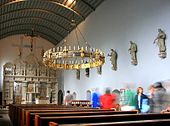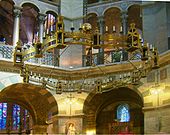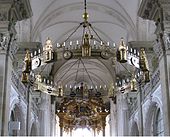Wheel candlesticks

A wheel chandelier is a lighting element , a chandelier hanging from the ceiling in the shape of a spoked wheel. The oldest and most important examples date from the Romanesque period .
Wheel chandeliers were made to illuminate large churches . But they also had symbolic value. Wheel candlesticks represent the paradise or the kingdom of God . The wreath and the gates and towers, which are mostly occupied by prophets and apostles or are inscribed with their names, depict the city wall of the heavenly Jerusalem . The number of supporting struts, towers and candles corresponds to the number twelve and its multiples of the number symbolism of the Revelation of John . This symbolism can be found for the first time on the two wheel lights that Bishop Bernward had made for the Hildesheim Cathedral and the church of his monastery foundation of St. Michael . The model was the large chandelier above the Golgotha of the Church of the Holy Sepulcher .
Byzantine wheel candlesticks
Wheel chandeliers (Choroi in Greek) were created in Byzantine art in the middle and late epoch (9th century to approx. 1450). A chorus from the 13th-14th centuries has been preserved. Century in the Archaeological State Collection Munich - Museum for Prehistory and Early History. It has a diameter of 350 cm and is 465 cm high without the hanging lamps. The chandelier is made of cast copper and consists of 1105 individual parts.
There are also medieval choroi from Serbia , some intact, some fragmented. At least two preserved medieval Serbian choroi are also royal foundations of Serbian kings. These are the Choros in the Visoki Dečani Monastery and the Markov Monastery near Skopje. It was built no earlier than the second half of the 14th century. The Choros in Dečani was restored in 1397 and hangs in its original place to this day. While the Münchner Choros is composed of standardized products, the decoration of the Choros by Dečani consists of individually made ornamental floral patterns and fantastic creatures. While the Byzantine wheel chandelier in Munich is made of cast copper, the two royal Serbian chandeliers were made of cast bronze. In the chorus of the Markov monastery, the bronze medallions made using the appliqué technique with royal inscriptions in the Church Slavonic alphabet are significant. The medallions bear the inscription of the Serbian king Vukašin Mrnjavčević or the coat of arms symbol of the double-headed Byzantine eagle. Individual parts can now be found scattered in the archaeological collections in the National Museum in Belgrade, the Archaeological Museum in Istanbul and the National History Museum in Sofia.
Ottoman wheel candlesticks
From the Ottoman period there are wheel chandeliers in the Athos monasteries of Xeropotamou , Koutloumousiou and Dionysiou , in which Ottoman animal ornaments can be found.
Romanesque wheel candlesticks
There are still four large Romanesque wheel chandeliers in Germany. The fact that they are made of fire-gilt copper , rather than pure gold , kept them from melting down. Most of the prophets and angel figures made of silver , as well as the often rich precious stones, were largely lost.
- The Barbarossa chandelier in Aachen Cathedral is attributed to Friedrich I (Barbarossa).
- The Hartwig chandelier on the Comburg near Schwäbisch Hall with a diameter of 5 meters from the 12th century (also called The Heavenly Jerusalem , with saints and soldiers in the towers).
- The Hezilo chandelier in Hildesheim Cathedral with a diameter of 6 meters is attributed to Bishop Hezilo (1054-1079).
- The Thietmar candlestick of Hildesheim Cathedral with donor inscription from Bishop Thietmar (1038-1044).
Gothic wheel candlesticks
In the minster church of St. Alexandri in Einbeck there is a late Gothic wheel chandelier with a diameter of about 3.50 m made of painted brass. The year 1420 is written on the inscription on the support crown. It was probably donated by a canon of the collegiate church, Degenhard Ree. The composition is said to be based on a model that has not survived in Pöhlde Monastery. In St. Stephan's Cathedral and St. Sixtus of Halberstadt, another [late] Gothic, bronze candlesticks of 1516 found.
Neo-Romanesque wheel candlesticks
In some neo-Romanesque churches there are also large wheel chandeliers, some of which were already electrified when they were installed, for example:
- St. Godehard's Basilica in Hildesheim, donated by Queen Marie of Hanover in 1864
- St. Cäcilia in Harsum (around 1886)
- Saint-Pierre-le-Jeune catholique in Strasbourg (around 1890)
- Bethlehem Church in Hanover-Linden-Nord (around 1904)
- St. Elisabeth in Bonn under the corresponding dome painting (around 1910) (electrified from the start)
Contemporary wheel candlesticks
There are also contemporary wheel chandeliers that tie in with this tradition, e.g. B .:
- Herrenhausen Church in Hanover (approx. 1990)
- Great St. Martin in Cologne (before 1993)
- Church in the Lippoldsberg Monastery (1999)
The copper choros in today's St. Mark's Church in Belgrade and that for the cathedral of St. Sava are based on the Serbian medieval choroi. The chorus in St. Mark's Church is still considered to be one of the largest in the world. It will be surpassed by the bronze chorus that will be hung in the Church of Saint Sava in Belgrade until October 2020 . This cast bronze chorus, which comes from a project by Nikolai Muchin , is being created at the Russian Academy of Arts in Moscow. With a diameter of 20 m and a weight of 14 tons, it will be installed 7.5 m above the church floor and abutments will be attached to the walls of the church at 12 points.
literature
- Hans Sedlmayr: The development of the cathedral . Zurich 1976. pp. 125-130
- Clemens Bayer: The two large inscriptions on the Barbarossa chandelier . In: Celica Jherusalem. Festschrift for Erich Stephany. Edited by Clemens Bayer. Cologne 1986. pp. 213-240
- Bernhard Gallistl: Meaning and use of the large crown of lights in the Hildesheim cathedral . In: Concilium Medii Aevi 12 (2009) pp. 43–88, cma.gbv.de (PDF; 2.9 MB)
- Rolf Dieter Blumer, Ines Frontzek: Researched and mapped. The Hertwig chandelier from Comburg . In: Denkmalpflege in Baden-Württemberg , 41st year 2012, issue 4, pp. 194–199, denkmalpflege-bw.de (PDF)
Web links
- The wheel chandelier. Klosterkirche.de
- Wheel candlesticks. Images in the image index of art and architecture
Individual evidence
- ↑ Hans Sedlmayr: The development of the cathedral. Pp. 125-128.
- ↑ Bernhard Gallistl: Meaning and use of the large crown of lights in Hildesheim Cathedral. Pp. 44-45; 76-79.
- ↑ Anna Ballian 2004: 60. Choros. In: Helen C. Evans 2004 (edit.): Byzantium Faith and Power (1261-1577). The Metropolitan Museum of Art, New York. pp.125. ISBN 1.158839-113-2
- ↑ Anna Ballian 2004: 60. Choros. In: Helen C. Evans 2004 (edit.): Byzantium Faith and Power (1261-1577). The Metropolitan Museum of Art, New York. pp.125. ISBN 1.158839-113-2
- ↑ Dragomir Todorović 2004: 61A, B. Medaillons from a Hanging Lamp (Choros). In: Helen C. Evans 2004 (edit.): Byzantium Faith and Power (1261–1577). The Metropolitan Museum of Art, New York. pp.126. ISBN 1.158839-113-2
- ^ Franz Hoffmann: St. Alexandri Einbeck . In: Large architectural monuments . 2nd Edition. No. 318 . Deutscher Kunstverlag, Munich 1981.
- ↑ Church . Catholic parish of St. Elisabeth Bonn. Retrieved May 19, 2013.
- ^ Website of the monastery church , accessed on January 17, 2018.
- ↑ Observer, February 24, 2020 Veličanstveni mozaik u Hramu Svetog Save







